Vol. 68, No. 8 (2019)
2019-04-20
GENERAL
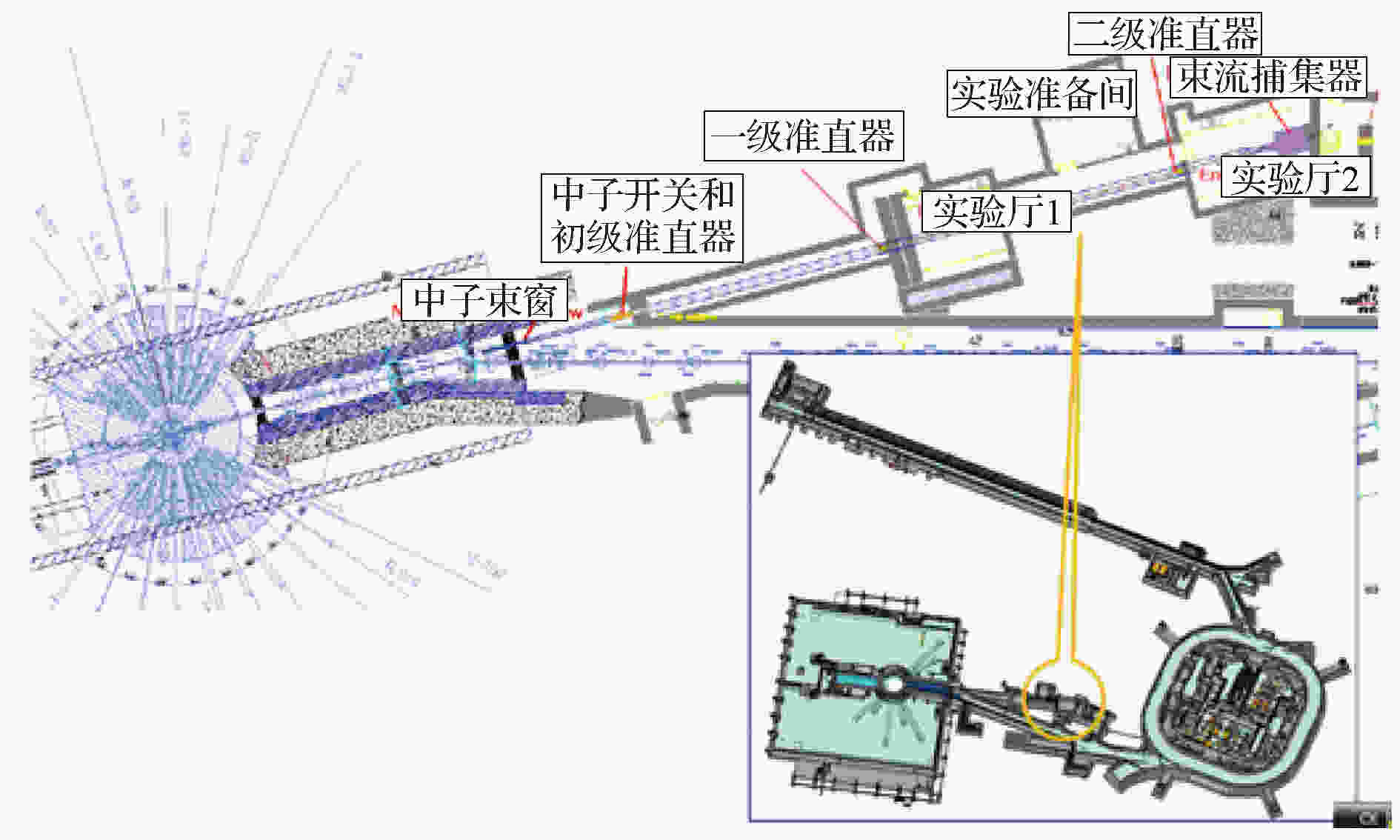
2019, 68 (8): 080101.
doi: 10.7498/aps.68.20182191
Abstract +
The Chinese spallation neutron source was completed in May 2018 and then subsequently commissioned. The Back-streaming white neutron beam line can be used in neutron nuclear data measurement, neutron physics research, and nuclear technology. In these experiments, it is necessary to know the neutron energy spectrum, the neutron flux, and the neutron beam profile of the neutron beam. In this paper, we present the preliminary measurements of these parameters. The neutron energy spectrum and neutron flux are measured by the time-of-flight method with a fission chamber equipped with 235U and 238U samples and a 6Li-Si detector. The neutron beam profile is measured by a scintillator-CMOS detection system. The preliminary experimental measurements of the beam line are obtained. Among them, the energy spectrum measurement range of white neutrons is from eV to more than 100 MeV, which also gives an uncertainty analysis; the neutron fluence rate gives the full power value of the two experimental halls; the collimated white neutron beam spot is given under a diameter of 60 mm. The future plan is also given. The results of these experimental parameters can serve as the foundation for the future nuclear data measurement and detector calibration experiments of the beam line.

2019, 68 (8): 080501.
doi: 10.7498/aps.68.20181856
Abstract +
Pulse signal detection is widely used in nuclear explosion electromagnetic pulse detection, lightning signal detection, power system partial discharge detection, electrostatic discharge detection, and other fields. The signal strength becomes weak with the increase of the detection distance and may be submerged in strong Gaussian noise for remote detection. Therefore, the detection and recovery of the weak signals, especially the weak pulse signals, have important applications in signal processing area. Some methods have been reported to detect and estimate weak pulse signals in strong background noise. Coupled Duffing oscillators are usually used in processing periodic signals, though it is still in an exploration stage for aperiodic transient signals. There remain some problems to be solved, for example, the system performance depends on some initial values, results are valid only for the period-doubling bifurcation state, the waveform time domain information cannot be accurately estimated, etc. In this paper, we explain the reasons why there exist these inherent defects in the current weakly coupled Duffing oscillators. In order to solve the above-mentioned problems, a new signal detection and recovery model is constructed, which is characterized by coupling the restoring force and damping force of the two oscillators simultaneously. A large coupling coefficient is applied to the two Duffing oscillators, and a generalized " in-well out-of-synchronization”phenomenon arises between the oscillators which conduces to detecting and recovering the weak pulse signals, and also overcoming the defects mentioned above. Using the metrics of signal-to-noise ratio improvement (SNRI) and waveform similarity, the effects of amplitude and period of periodic driving force, coupling coefficient, step size and damping coefficient on signal detection and waveform recovery are studied. Finally, experiments are performed to detect and recover the following three kinds of pulses: square wave pulses, double exponential pulses, and Gaussian derivative pulses. The input SNR thresholds of these three waveforms are –15, –12, and –16 dB, respectively, under the detection probabilities and waveform similarity all being greater than 0.9 simultaneously. The maximum error of the pulse amplitude and pulse width are both less than 5% of their corresponding true values. In summary, the strongly coupled Duffing system has advantages of being able to operate in any phase-space state and being no longer limited by the initial values. Especially, the time domain waveform of weak pulse signals can be well recovered in the low SNR case, and the error and the minimum mean square error are both very low.

2019, 68 (8): 080201.
doi: 10.7498/aps.68.20182231
Abstract +
Quantum chemical calculation is an important method to investigate the molecular structures for multi-atom molecules. The determination of electronic configurations and the accurate description of the symmetry of molecular orbitals are critical for understanding molecular structures. For the molecules belonging to high symmetry group, in the quantum chemical calculation the sub-group is always adopted. Thus the symmetries of some electric states or some molecular orbitals, which belong to different types of representations of high symmetry group, may coincide in the sub-group presentations. Therefore, they cannot be distinguished directly from the sub-group results. In this paper, we provide a method to identify the symmetry of molecular orbitals from the theoretical sub-group results and use this method to determine the symmetry of the highest occupied molecular orbitals (HOMO) of the sulfur hexafluoride SF6 molecule as an example. Especially, as a good insulating material, an important greenhouse gas and a hyper-valent molecule with the high octahedral $ O_h $ symmetry, SF6 has received wide attention for both the fundamental scientific interest and practical industrial applications. Theoretical work shows that the electronic configuration of ground electronic state $ ^1{\rm A_{1g}} $ of SF6 is ${({\rm {core}})^{22}}{(4{\rm a_{1\rm g}})^2}{(3{{\rm t}_{1\rm u}})^6}{(2{{\rm e}_{\rm g}})^4}{(5{{\rm a}_{1\rm g}})^2}{(4{{\rm t}_{1\rm u}})^6}{(1{{\rm t}_{2\rm g}})^6}{(3{{\rm e}_{\rm g}})^4}{(1{{\rm t}_{2\rm u}})^6}{(5{{\rm t}_{1\rm u}})^6}{(1{{\rm t}_{1\rm g}})^6} $ and the symmetry of the HOMOs is $ T_{1g} $ . However, in some literature, the symmetry of HOMOs of SF6 has been written as $ T_{2g} $ instead of $ T_{1g} $ . The reason for this mistake lies in the fact that in the ab initial quantum chemical calculation used is the Abelian group $ D_{2h} $ , which is the sub-group of $ O_h $ , to describe the symmetries of molecular orbitals of SF6. However, there does not exist the one-to-one matching relationship between the representations of $ D_{2h} $ group and those of $ O_h $ group. For example, both irreducible representations $ T_{1g} $ and $ T_{2g} $ of $ O_h $ group are reduced to the sum of $ B_{1g} $ , $ B_{2g} $ and $ B_{3g} $ of $ D_{2h} $ . So the symmetry of the orbitals needs to be investigated further to identify whether it is $ T_{1g} $ or $ T_{2g} $ . In this work, we calculate the orbital functions in the equilibrium structure of ground state of SF6 by using HF/6-311G* method, which is implemented by using the Molpro software. The expressions of the HOMO functions which are triplet degenerate in energy are obtained. Then by exerting the symmetric operations of $ O_h $ group on three HOMO functions, we obtain their matrix representations and thus their characters. Finally, the symmetry of the HOMOs is verified to be $ T_{1g} $ . By using this process, we may determine the molecular orbital symmetry of any other molecules with high symmetry group.

2019, 68 (8): 080301.
doi: 10.7498/aps.68.20182013
Abstract +
Solitons as self-supported solitary waves are one of the most fundamental objects in nonlinear science. With the realization of Bose-Einstein condensate, matter-wave solitons have aroused enormous interest due to their potential applications in atomic transport and atomic interferometer. In recent years, the artificial spin-orbit coupling has been realized in ultracold atoms, thus providing a new platform to study the nonlinear matter wave solitons under a gauge field, and a variety of novel soliton phenomena have been successively predicted. In this paper, we analyze the effects of linear Zeeman splitting on the dynamics of bright-bright solitons in spin-orbit coupled two-component Bose-Einstein condensate, via the variational approximation and the numerical simulation of Gross-Pitaevskii (GP) equations. For the SU(2) spin-rotational invariant attractive atomic interaction in a uniform case without external trap, we take a hyperbolic secant function as the variational Ansatz for bright soliton in variational approximation, and derive the Euler-Lagrange equations describing the evolution of the Ansatz parameters. By solving the time-independent Euler-Lagrange equations, we find two stationary solitons each with a finite momentum for a weak spin-orbit coupling due to the linear Zeeman splitting. Linearizing the Euler-Lagrange equations around these stationary solitons, we further obtain a zero-energy Goldstone mode and an oscillation mode with frequency related to linear Zeeman splitting: the former indicates that the continuous translational symmetry of the stationary solitons will be broken under a perturbation, and the later shows that the stationary solitons will oscillate under a perturbation. Furthermore, by solving the time-dependent Euler-Lagrange equations, we also obtain the exact full dynamical solutions of Ansatz parameters, and observe that the linear Zeeman splitting affects the period and velocity of soliton's oscillation and linear motion, which may provide a new method to control the dynamics of solitons. All the variational calculations are also confirmed directly by the numerical simulation of GP equations.
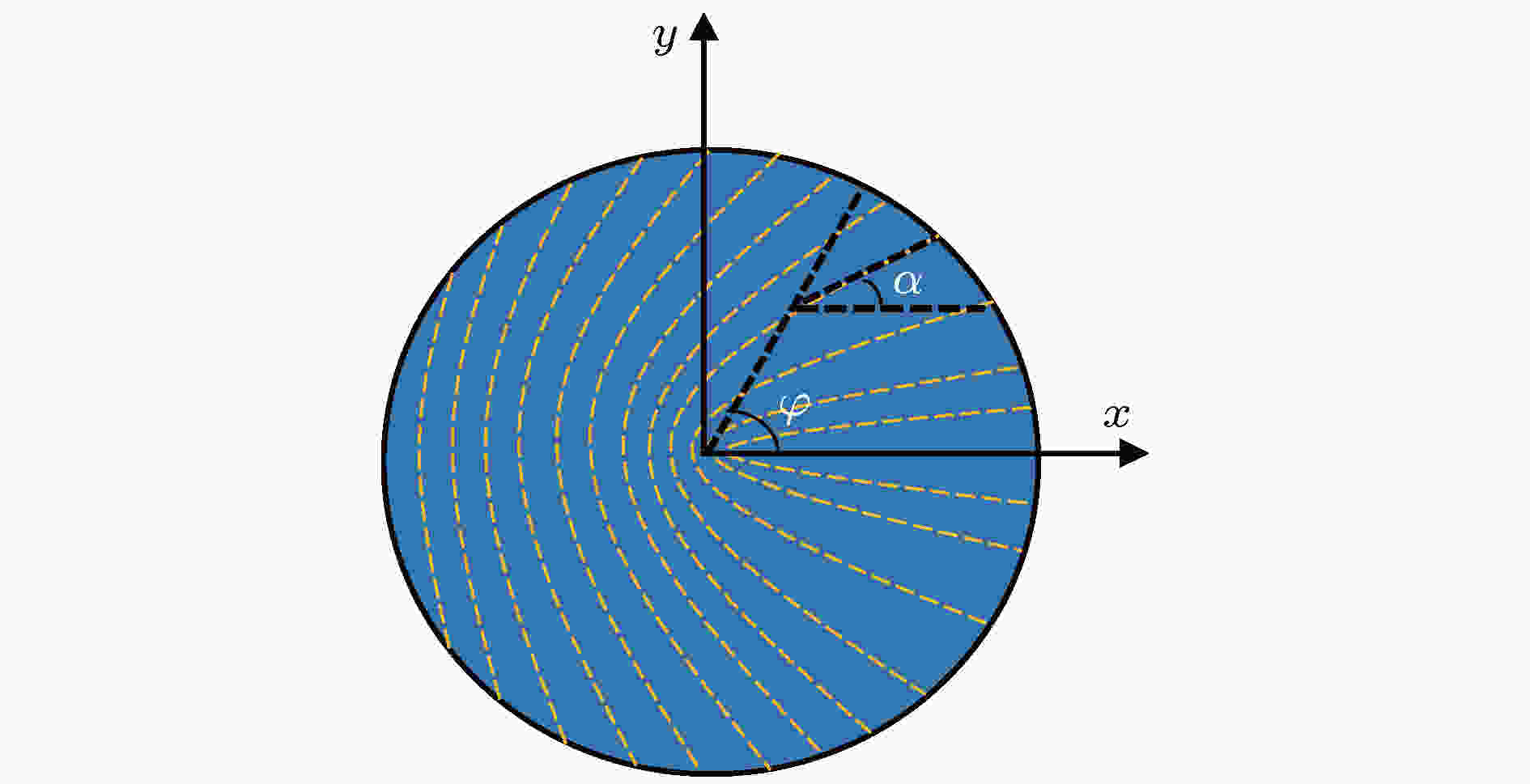
2019, 68 (8): 084202.
doi: 10.7498/aps.68.20181902
Abstract +
With the rapid development of computer network technology, information security has drawn considerable attention in recent years. Owing to the characteristics of multi-dimensional operation and parallel processing capability, optical image encryption techniques are arousing great interest in many exciting fields. Since the pioneering work on optical image encryption using double random phase encoding technique, a large number of algorithms and architectures have been proposed and realized. However, with the further analysis of the securities of these schemes, most of them have been verified to be vulnerable to different types of attack algorithms. Recently, optical encryption schemes based on the polarization properties of light wave have been extensively studied, for an additional flexibility in the encryption key design is provided, which can achieve high robustness against brute force attack by a combination of multiple private keys. Nevertheless, optical encryption schemes based on the polarization properties of light wave could still be vulnerable to known- and chosen- plaintext attacks. Therefore, in this paper, a novel asymmetric polarization encryption method is implemented for dual images, and combined with interference-based optical image encryption method and a Q-plate. First, the information about the two images to be encrypted is separated into two pure phase plates by means of interference optical image encryption, which will be further encoded into two mutually orthogonally polarized light beams. Next, the Q-plate and pixelated polarizer are used for realizing different polarization distributions of the two light beam. Ultimately, the output intensity distribution is recorded by a charge coupled device (CCD) which will be treated as the final ciphertext. For actualizing the asymmetric encryption, one of the pure phase plates acts as a decryption key, which is different from the encryption key. We can control the polarization state of each pixel according to the parameter q, causing the Q-plate to be electrically controllable and the optic-axis orientation of each pixel to differ from one another. It should be emphasized that the value of q and the polarization angle of the pixelated polarizer play the role of two encryption keys, which improves the security of the algorithm extremely, due to their high sensitiveness. Theoretical analyses and numerical simulations verify the feasibility and effectiveness of the proposed encryption scheme.
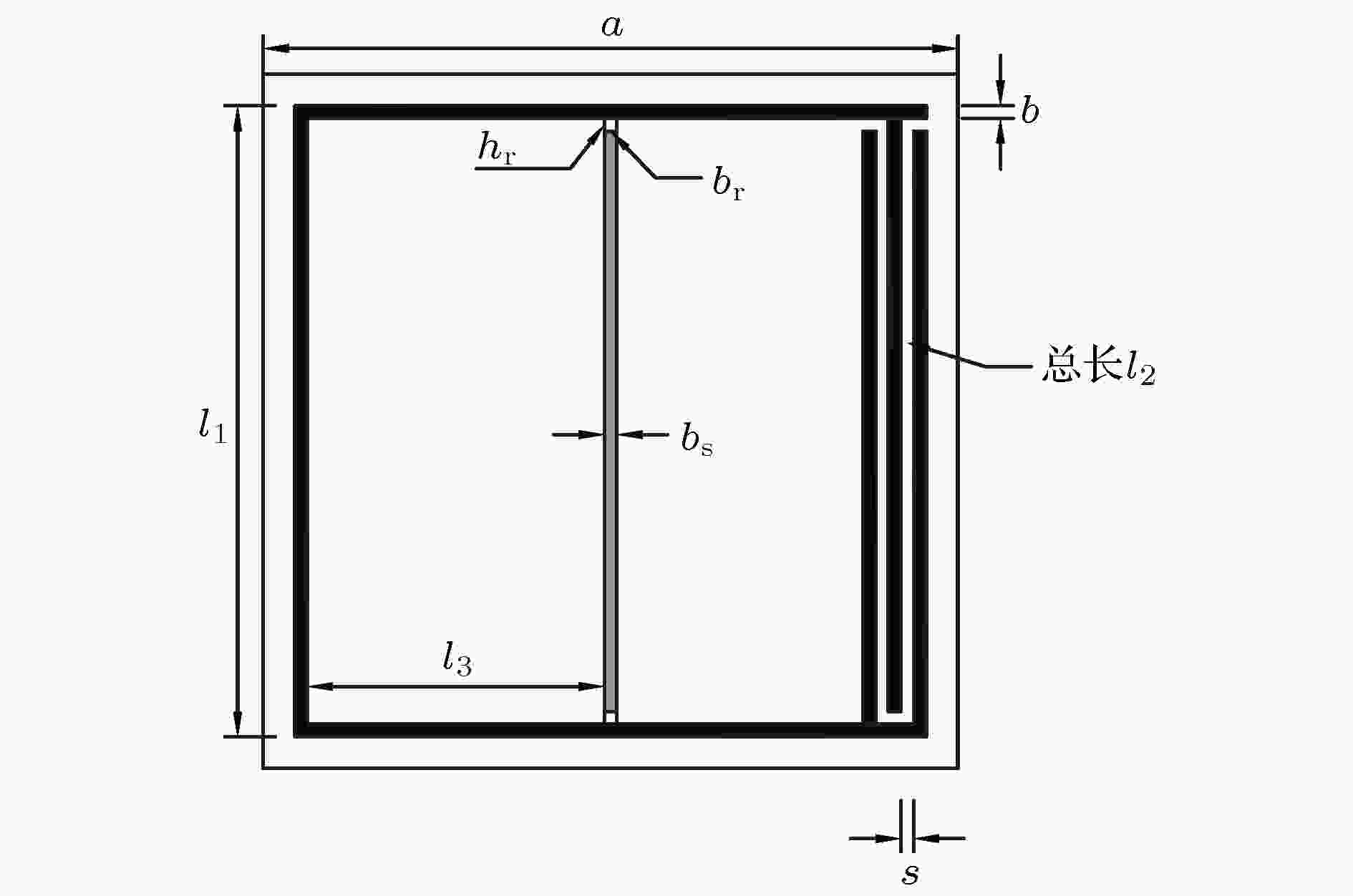
2019, 68 (8): 084302.
doi: 10.7498/aps.68.20182102
Abstract +

2019, 68 (8): 087801.
doi: 10.7498/aps.68.20182087
Abstract +
BaTiO3 (BTO) is a typical studying object both in ferroelectrics and in material science. By the GW method, optical property of BTO is investigated, and its volume effect under the case of iso-strain is also studied. It is found that the results of excited states are closer to the experimental results with the consideration of electron-hole interaction in the framework of GW method. Considering the volume effect, we obtain that the red shift of the peaks of optical absorption occurs under the expansion of volume, and the blue shift appears when the BTO is compressed. At the same time, the polarization and the hybridization between d orbital of Ti atom and p orbital of O atom are enhanced for the case of volume expansion, however, things will be opposite under the compression of volume. Furthermore, the volume effect in the iso-strain case is less dramatic than in the iso-stress case.
NUCLEAR PHYSICS

2019, 68 (8): 082801.
doi: 10.7498/aps.68.20182069
Abstract +
With traditional neutron activation analysis, the increase of sample quality leads to some problems in both irradiation process and measurement process. These problems include the neutron flux gradient in the range of the sample, the decrease of the thermal neutron flux rate around the sample and the influence of self-shielding in the sample in the irradiation process, In the process of measurement, the self-attenuation of γ-ray in the sample and the geometric effect of the sample lead to the effect of the detector on the measurement of characteristic γ-ray emissivity due to the difference in the detection efficiency of each point of the sample. So the neutron activation analysis of mass sample needs to make some additional modifications. By using the neutron activation analysis technique, the content of 24Mg and 28Si in a large amount of flour can be detected, and the content of talc powder in the flour can be given, so that the quality of flour can be monitored. The flour mainly contains C, H, O, N, Ca, and F element, but the main chemical constituent of talc powder is Mg3[Si4010](OH)2. Therefore, the measured content of Si and Mg element can be used to judge whether the flour contains talcum powder and to determine its exact content. When the content of 24Mg and 28Si in flour are measured by the neutron activation analysis, the variation of neutron flux and energy with thickness in the measured sample and the effect of γ-ray self-absorption will have great influence on the measurement results. The relationship between the neutron flux and energy and the thickness of the sample is simulated by MCNP5 (Monte Carlo N-particle transport code system 5), and the neutron fluxes at different thickness of the sample are measured by a 3He proportional counter tube. The results show that the simulation results of MCNP5 are basically consistent with the experimental results. Using the simulation by MCNP5 and the measurements by a sodium iodide detector, the relationship between γ-ray self-absorption effect and sample thickness is studied, and the sample thickness is determined to be 6.6.cm that is adopted as an optimal experimental condition. Based on the simulated data, the function relationship between the counting of 1.779 MeV γ-ray and the thickness of the sample is obtained as follows: A = 1401 + 3815x – 720x2 + 64x3 – 2.8x4 + 0.05x5. The curve trend of the experimental results is basically the same as that of the simulation results.
ATOMIC AND MOLECULAR PHYSICS

2019, 68 (8): 083401.
doi: 10.7498/aps.68.20182141
Abstract +
In the present work, the long-range interaction potential part of potential energy surface (PES) of OH2+ system is revised and the new resulting PES apparently is more reasonable than the old one in the long-range part. Based on the new PES, the dynamics calculations of O+ +H2→ OH+ + H reaction are carried out at a state-to-state level of theory by using time-dependent quantum wave packet method with second order split operator in a collision energy range from 0.01 to 1.0 eV. The dynamic properties such as reaction probability, ro-vibrational resolved statereaction probability, integral cross section, differential cross section, and state specific rate constant are calculated and compared with available theoretical and experimental results. The results of ro-vibrational resolved state reaction probability reflect some dynamic properties such as resonances which is attributed to the deep well located on the reaction path. The vibrational resolved state reaction probability indicates that the excitation efficiency of the OH+ product is relatively low. The results of integral cross sections indicate that the present results are in better agreement with the experimental values than with previous theoretical calculations, especially in the low collision energy region. However, the state specific rate constant results underestimate the experimental values. The comparison betweenour calculations and the experimental results indicates that the contribution of the rotational excitation of H2 molecule should be included in the calculations. However, only the initial state v = 0, j = 0 is calculated in the present work. We suppose that the deviation of the present results from the experimental data is due to the fact that the rotational excitation of reactant isnot included in the present calculation. The differential cross section signals indicate that the complex-forming reaction mechanism isdominated in the case of low collision energy, but it transforms into abstract reaction mechanism as the collision energy further increases.
ELECTROMAGNETISM, OPTICS, ACOUSTICS, HEAT TRANSFER, CLASSICAL MECHANICS, AND FLUID DYNAMICS

2019, 68 (8): 084101.
doi: 10.7498/aps.68.20182194
Abstract +
Beam loading is an important parameter in extended interaction klystron, which can be used to analyze the influence of beam on resonant frequency and ohm loss Q, and study the match condition between input cavity and external power source, etc. Based on the kinematical theory, law of induce current, principle of charge conservation under the small signal condition, and one-dimensional (1D) mode, the transit time effect of electron in ${\text{π}}$ mode standing wave electric treld in a multiple-gap resonator is analyzed, and the expressions of electron load conductance and electron load susceptance in the multiple-gap resonator are presented. The results show that the electron load conductance of extended interaction cavity can change in a bigger extension than that of traditional single gap cavity, which means that the loaded Q of extended interaction cavity can be adjusted in a bigger extension to realize a desired Q. And the results also show that the electron load susceptance of extended interaction cavity can change in a bigger extension than that of traditional single gap cavity, which means that the loaded frequency of extended interaction cavity can also be easily adjusted to a desired value. The influence of gap number on the power exchange between beam and microwave is also investigated, which shows that the maximum power exchange between beam and microwave electric field increases with the number of resonator gaps increasing, and so does the efficiency of klystron. A W band extended interaction klystron amplifoer is designed by the above theory analysis and three-dimensional (3D) PIC code. The simulation results show that when beam voltage is 20.8 kV, current is 0.28 A, input power is 30 mW at a frequency of 94.77 GHz, the extended interaction klystron can produce 443 W output power. The responding electron efficiency is 7.6%, the gain is 41.7 dB, and the 3 dB bandwidth exceeds 150 MHz. The extended interaction klystron is machined and tested, and the experimental results show that the maximum output power of 175 W is obtained with a beam of 300 mA, a voltage of 20.8 kV, and an input microwave power of 30 mW at a frequency of 95.37 GHz in a magnetic field of 0.62 T. The responding electron efficiency is 2.8%, the gain is 34.6 dB, the 3-dB bandwidth exceeds 90 MHz. This study is meaningful for designing and developing greater power extended interaction klystrons.
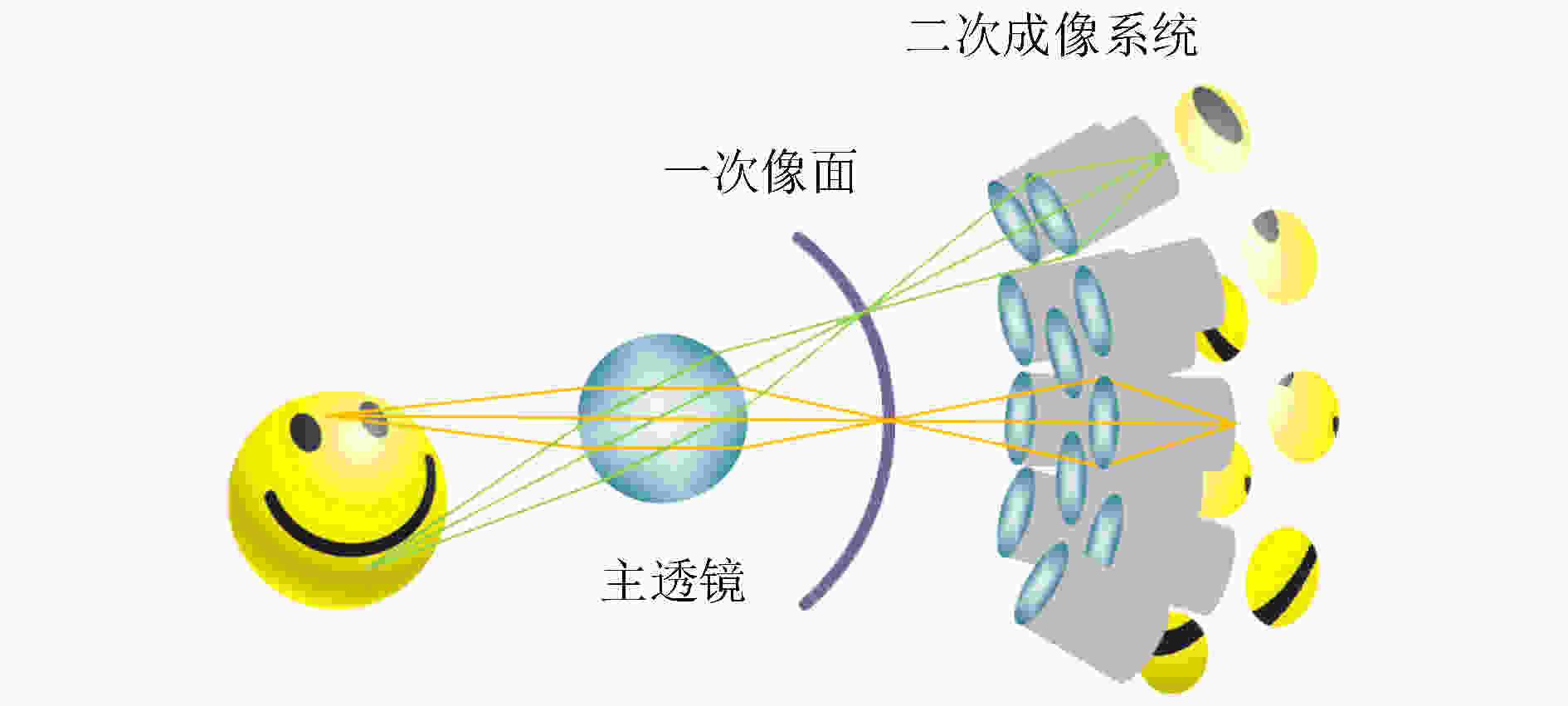
EDITOR'S SUGGESTION
2019, 68 (8): 084201.
doi: 10.7498/aps.68.20182229
Abstract +
Imaging systems with a wide field-of-view (FOV) and high-resolution, which can provide abundant target information, are always desired in various applications including target detection, environment monitoring, marine rescue, etc. Various approaches to realizing the wide FOV and high-resolution imaging have been developed, for example, fisheye lens imaging system, and panoramic optical annular staring imaging technology. In these single aperture imaging systems, the maximum resolution and FOV are determined by either the geometric aberration or the diffraction limit of the optics. Multi-scale monocentric ball-lens imaging system is of particular importance due to its high real-time ability, small image distortion, and wide FOV. The complete geometrical symmetry of multilayer monocentric ball-lens makes it possible to compensate for the geometric aberration with no need of additional assistance. However, the major problem in designing imaging system based on multi-scale monocentric ball-lens is that there are too many variables needed to be set for a ball-lens imaging structure and the problems of high time cost and computation complexity.For simplifying the design process, in this manuscript, we apply the computational imaging theory to optical system design, thereby developing a geometric aberration optimization function to determine the initial values of the desired system by the sound computation rather than repetitive iterations by using the optical system design software. Function development starts from the aberration theory. Since the monocentric ball lens does not bring in the aberrations relating to FOV, only spherical aberration and chromatic aberration are needed to be considered. The optimization function is then founded according to the principle of minimizing the spherical aberration and chromatic aberration. And then with the determined initial parameters, ZEMAX is employed to globally optimize the residual geometric aberrations, which is time-efficient. After required parameters are finally determined, the system performance is evaluated via the modulation transmission function, the spot diagram distribution, the field-curve and distortion value and the ray fan curve. Favorable results are obtained, which demonstrates the feasibility of the developed system designing approach. Imaging results from the finished prototype system are pretty satisfactory with wide FOV and high resolution which is captured through only one frame. The multi-scale wide FOV and high-resolution computation imaging system not only solves the conflict between the wide FOV and high resolution, but also provides the research foundation for computational imaging.
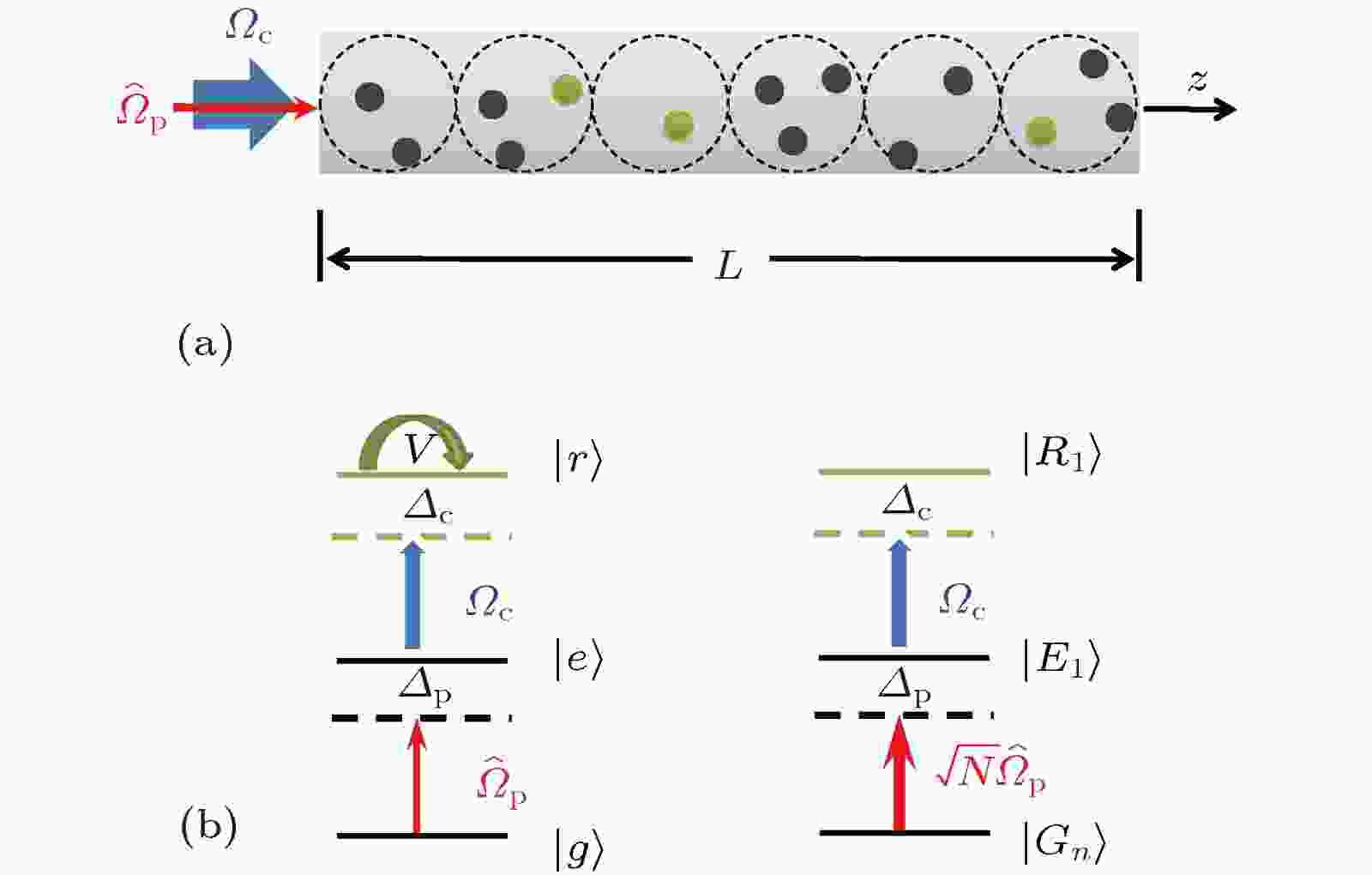
2019, 68 (8): 084203.
doi: 10.7498/aps.68.20181938
Abstract +
Transmission properties of a weak probe field traveling through a sample of interacting cold 87Rb atoms driven into the three-level ladder configuration, which is a typical Rydberg electromagnetically induced transparency (EIT) system, are investigated. Rydberg atoms are considered to be a perfect platform in the research fields of quantum optics and quantum information processing due to some exaggerated properties of Rydberg atoms with high principal quantum number, especially, the dipole-dipole interaction between Rydberg atoms leads to the so-called dipole blockade effect accommodating at most one Rydberg excitation within a mesoscopic volume. The dipole blockade effect may be mapped onto the spectrum of EIT, and the EIT exhibits the cooperative optical nonlinearity which is usually characterized by two indicators, i.e., the probe intensity and the photonic correlation. The cooperative optical nonlinearity is also found here in the phase of transmission spectrum, and the phase can be regarded as the third indicator of nonlinearity in Rydberg EIT. However, there are tremendous differences between the phase and probe transmission (photonic correlation) though they both originate from the conditional polarization. Specifically, the phase is not sensitive to neither the incident probe intensity nor the initial photonic correlation at the resonant probe frequency under the condition of the Autler-Townes (AT) splitting where two other indicators exhibit significant cooperative nonlinearity. The nonlinearity in phase spectrum occurs only in the regime between the resonant probe frequency and the AT splitting and especially is remarkable at the frequency where the probe field is classical. Finally, influence of the principal quantum number and the atomic density on the transmitted phase are examined. In the nonlinear regime, the absolute value of the phase becomes smaller and smaller as the principal quantum number and the atomic density are raised. This indicates that the nonlinearity is strengthened by increasing them. The probe phase provides an attractive supplement to study in depth the cooperative optical nonlinearity in Rydberg EIT and offers us the considerable flexibility to manipulate the propagation and evolution of a quantum light field.
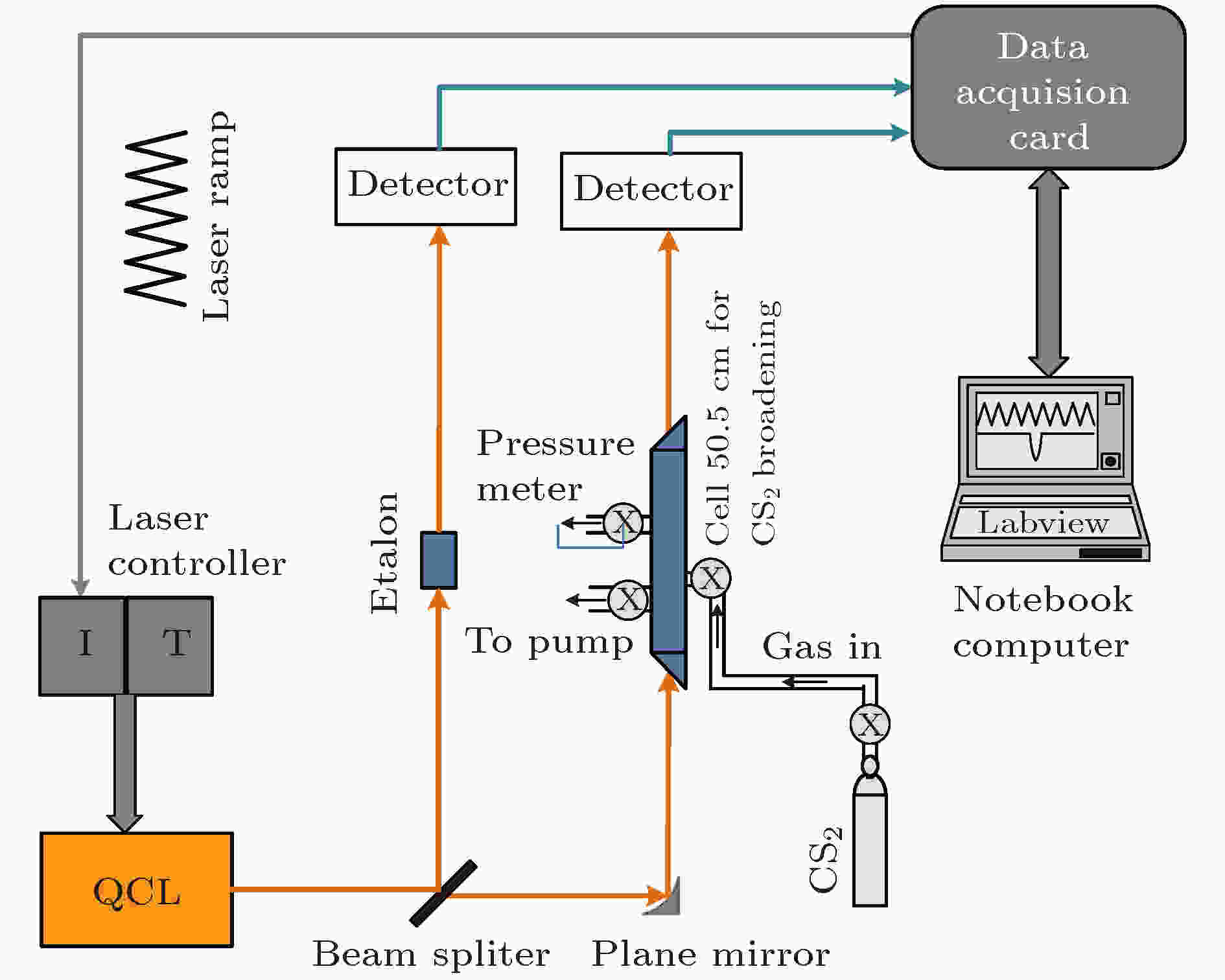
2019, 68 (8): 084204.
doi: 10.7498/aps.68.20182140
Abstract +
Carbon disulfide (CS2) is a toxic volatile sulfur compound with flammability and harmfulness, which can seriously harm the human health and threaten the industrial production safety. Therefore, it is of high importance for monitoring CS2 concentration in the air. Tunable diode laser absorption spectroscopy is very suitable for the detection of trace gas for it possesses high sensitivity and fast response. And the precise knowledge of spectroscopic parameters is essential for deducing the CS2 concentration. However, primary database including HITRAN and GEISA lacks spectroscopic parameters of CS2. Thus, to address this issue, a measurement system of absorption spectrum is built for determining spectroscopic parameters by using a quantum cascade laser with narrow linewidth and high output power operating near 4.6 um as a light source. In this paper, direct absorption spectroscopy is used to measure the CS2 absorption spectra under different sample pressures and the environment temperature is controlled at 296 K, which is adjusted by an air conditioner. We intensively study the absorption spectra of CS2 in a range between 2178.99 and 2180.79 cm–1.According to the relevant reports and the need of actual measurement, four absorption lines are mainly measured in a range of 2180.5−2180.74 cm–1. Combining with the multiple linear regression algorithm based on the nonlinear least-square method and Beer-Lambert law, the integrated area and Lorentz line width of measured CS2 absorption spectrum can be determined. Then the spectroscopic parameters including absorption line intensity and air broadening coefficient are precisely obtained by linearly fitting the integrated areas and Lorentz line widths of CS2 absorption spectra at different pressures. Moreover, nitrous oxide (N2O) absorption spectrum with high spectral resolution is measured to calibrate the central position of carbon disulfide absorption line according to its known line position extracted from HITRAN database and the results obtained by etalon. The calculated results show that the uncertainty of line intensity and air broadening coefficient are less than 5% and 15%, respectively. It demonstrates that the measured spectroscopic parameters of four absorption lines for this study can be recorded in the database of HITRAN, which is very important for trace gas sensing of CS2. In the future, we will further improve the system for measuring CS2 absorption line parameters to fill in the gaps in their spectral parameters in HITRAN and GEISA databases.

COVER ARTICLE
2019, 68 (8): 084206.
doi: 10.7498/aps.68.20181890
Abstract +
In this paper, a novel tunable mode-filter optical fiber consisting of a high-index core and petal-shaped cladding surrounded by a high-index outer ring is proposed. The cladding of the fiber is formed with periodically arranged liquid rods that support cladding modes with effective indexes. These cladding modes form a two-super-mode group. The mode-selection is realized by the coupling between the core mode and the super-mode group. With the petal-shaped cladding, cladding mode can be transmitted at high loss. With the liquid rods, the index-band of super-mode group can be adjusted by external temperature field, thereby achieving the purpose of tunable mode-selective. The super-mode group formed by the LP11 mode of the liquid rods effectively increases its operating bandwidth and temperature tuning range. The numerical simulation results show that the mode-filter fiber with a length of only 71.4 mm can achieve a particular mode loss more than 20 dB, while other modes’ losses are below 1 dB. This special fiber can be used as a mode-filter in the few-mode fiber transmission system to reduce mode crosstalk of converters, multiplexer/demultiplexer, optical switch and optical routing.

2019, 68 (8): 084207.
doi: 10.7498/aps.68.20182091
Abstract +
In the laser-driven inertial confinement fusion facilities, the irradiation uniformity of the laser beams on the target is a key factor affecting the effective compression of the target. At present, a variety of beam-smoothing techniques have been developed to control the spatiotemporal characteristics of the focal spots. However, many optical components involved in optical transmission links and complex transmission transformations often lead to complex optical transmission. Moreover, when using the diffraction optical method to analyze the shape and characteristics of the focal spots, a lot of data are needed to be processed and calculated, resulting in large calculation and low computational efficiency. It is urgent to find a new and fast method to describe the statistical properties of the focal spots. In addition, in the beam-smoothing technique, since the phase distribution of the continuous phase plate is obtained by multiple iterations of random numbers, although the details of focal spots obtained by different continuous phase plates are not the same, they all have similar statistical properties. Therefore, the modulation of the laser beam by the continuous phase plate can be regarded as the transmission process of the laser beam through a random surface. Although the intensities of the speckle within the focal spot at different locations have the strong randomness, and the random distributions of the target speckles obtained by different beam-smoothing methods are different, the overall distribution satisfies a certain statistical law. In this paper, the light-field properties of the focal spot are described by the statistical characterization method. The circular complex Gaussian random variables are used to directly describe the statistical properties of the target surface light field, and the far-field focal spots obtained by the diffractive optical method and those by the statistical characterization method are compared with each other and analyzed based on the typical focal spot evaluation parameters. The results show that the instantaneous properties of the focal spots obtained by the diffractive optical method and those obtained by the statistical characterization method are basically identical, but their time-integrated far-field focal spots are different. The correlation coefficient can be further used to describe the time-varying properties of the far-field focal spots. Compared with the diffractive optical method, in the numerical calculation process, the statistical characterization method of light field properties can directly obtain the analytical expression of the statistical distribution of the light field according to the statistical properties of the continuous phase plate surface shape. Secondly, this method can avoid the numerical calculation process from near field to far field. Last but not least, there is no need to perform data processing on each point of the light field, which makes things simple and effective and does not require large-scale data storage and processing.
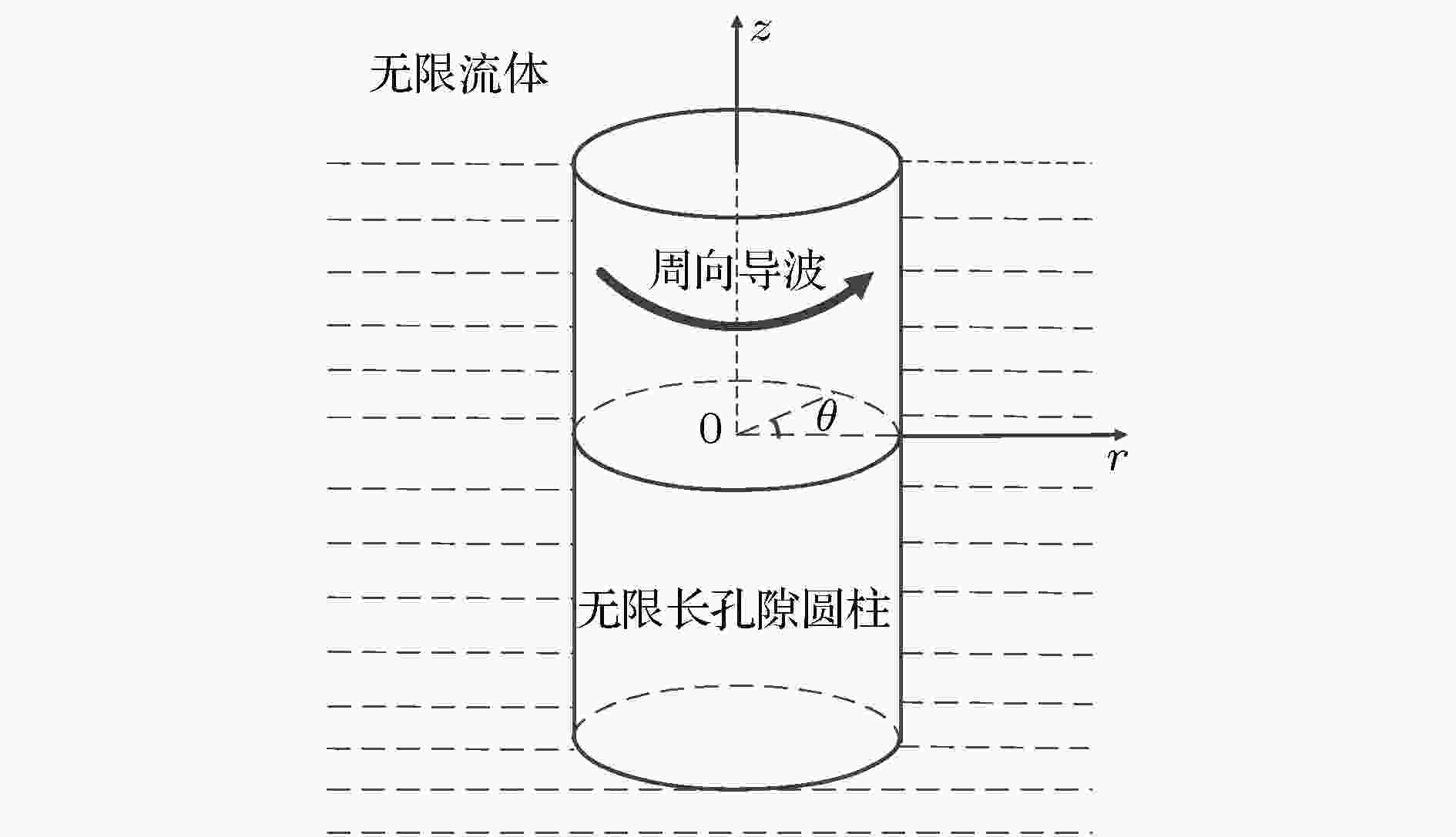
2019, 68 (8): 084301.
doi: 10.7498/aps.68.20182300
Abstract +
Underground water, gas and oil all exist in the fractured or porous strata. Waves that propagate through porous cylinder immersed in infinite fluid are of considerable interest in the estimation of porous parameter, such as an underwater concrete column may present pore characteristics after a long time water immersion. Compared with longitudinal guided wave, circumferential guided wave has its advantages in the ultrasonic nondestructive inspection of porous cylinder. In order to investigate the propagation characteristics of guided waves in a porous cylinder immersed in infinite fluid and analyze the effects of the porous medium parameters on the dispersion characteristic, a model of porous cylinder surrounded by fluid is built. Based on the elastic-dynamic theory and modified liquid-saturated porous theory, the characteristic equation of guided wave is established, and the dispersion curves are obtained numerically. The effects of cylindrical radius and pore parameters on the propagation characteristics of guided waves are discussed; the attenuation characteristics of guided waves are also analyzed; the time domain waveforms of the guided circumferential waves are obtained by numerical inversion, and the influence of porous parameters on waveforms is simulated. It is found that the dispersion curves are similar to that of elastic cylinder in the fluid, there exist multiple mode guided waves and approximate shear velocity of medium for higher modes, and higher order modes are more affected by the radius, but it does not change the tendency of curve. The phase velocity decreases with porosity increasing at the same frequency and the effect of porosity on higher order modes is greater than that on mode 1; due to the dissipation in the medium, the attenuation increases porosity increasing. It can be seen from the transient responses that the wave packets move backward and the displacement amplitude decreases with the porosity increasing. The characteristics of the inversed transient response are in good agreement with theoretical dispersion and attenuation. The results show that the propagation of guided circumferential wave is affected by the pore parameters, especially for porosity, which can provide a theoretical reference for the non-destructive evaluation of the porous cylinder surrounded by infinite fluid.
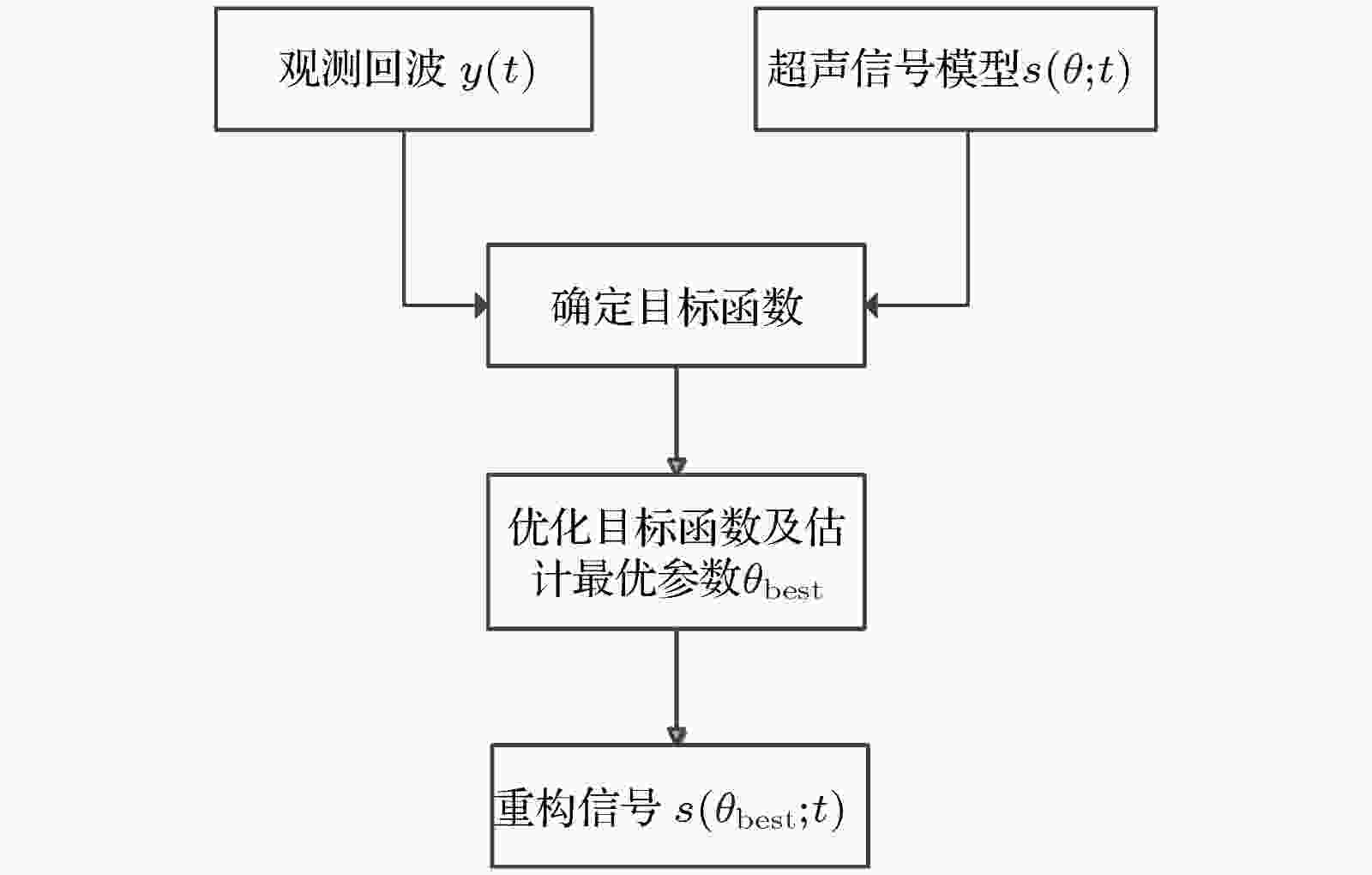
2019, 68 (8): 084303.
doi: 10.7498/aps.68.20182080
Abstract +
Ultrasonic non-destructive testing, which is one of the most important and rapidly developed non-destructive testing technologies, is widely used in industrial production and other areas. Signal de-noising and feature extraction, whose performance directly affects the evaluation of non-destructive testing results, are the key technologies of ultrasonic non-destructive testing data processing, and also the core elements of ultrasonic non-destructive testing. Therefore, the research on them has important academic significance and practical value. In order to solve the problem of parameter estimation and noise reduction of ultrasonic echo in strong noise background, a novel ultrasonic echo processing method is proposed in this paper. The principle of the proposed method in this paper is as follows. The ultrasonic echo, which is generated by modulating the ultrasonic transducer, has a specific structure, but the noise in practical engineering is usually a Gauss random process, therefore the noise is independent of the ultrasonic signal structure. In this paper, the problem of parameter estimation and noise reduction of ultrasonic echo signal are converted into a function optimization problem by establishing the model of ultrasonic signal, determining the objective function, optimizing the objective function, estimating the parameters, and reconstructing the ultrasonic signal. Firstly, a dual gaussian attenuation mathematical model of ultrasonic signal is established based on practical engineering experience. Secondly, the cosine similarity function, an effective measure of data sequence similarity, is selected as an objective function according to the observed echo and the established ultrasonic signal model. Thirdly, the artificial bee colony algorithm is selected to optimize the objective function to obtain the optimal estimation parameters of the ultrasonic signal from the noisy ultrasonic echo. Fourthly, the estimation of de-noising ultrasonic signal is reconstructed by the optimal parameters based on the established ultrasonic signal mathematical model. The processing results of simulated ultrasonic echoes and measured ultrasonic echoes show that the proposed method can accurately estimate the parameters of ultrasonic signal from strong background noise whose signal-to-noise ratio is lowest, as low as –10 dB. In addition, compared with the adaptive threshold based wavelet method and empirical mode decomposition method, the proposed method in this paper shows the good de-noising performance. Furthermore, compared with the commonly used exponential model and Gaussian model in numerical and simulation analysis, the proposed dual gaussian attenuation mathematical model of ultrasonic signal in this paper can well simulate the measured ultrasonic signal, with a mean square error of 9.4 × 10–5 and normalized correlation coefficient of 0.98.
Original Articles

2019, 68 (8): 084205.
doi: 10.7498/aps.68.20182275
Abstract +
Liquid crystal (LC) is an excellent tunable functional material which can be controlled by the external stimulus such as electric field, magnetic field and temperature. Terahertz (THz) radiation in a frequency range of 0.1−10.0 THz, has enormous advantages such as a low photon energy, sensitivity to crystal lattice vibration, magnetic spins, hydrogen bonds, intermolecular interaction, and water, and high transparency to non-conducting materials. The THz technology, therefore, has great potential in a diverse range of applications from spectroscopy, security screening to biomedical technology and high-speed wireless communication. But the development of high-performance LC based tunable THz functional devices is still in its infancy stage. The dispersion of LC refractive index induces a comparatively low birefringence in the THz regime. The lack of transparent electrodes makes the electric tuning of LCs difficult to achieve. To achieve certain modulations requires a very thick THz layer, leading to several disadvantages such as high operating voltage, slow response and poor pre-alignment. In this paper, we first present the research progress of large birefringence LCs in THz range. A room-temperature nematic LC NJU-LDn-4 with an average birefringence greater than 0.3 in a frequency range from 0.5 to 2.5 THz is shown in detail. This kind of LC can remarkably reduce the required cell gap, thus reducing the operating voltage and response time. Then we summarize varieties of conventional THz devices based on LC. Many electrodes are used for THz range. Graphene which can be used as a perfect transparent electrode material in THz band is proposed. Not only tunable transmissive but also reflective THz waveplates are introduced. The thickness of the LC layer of the reflective one can be reduced to ~10% of that needed for the same phase shift at a given frequency in a transmissive waveplate. The same tunability as that in the transmissive type just needs half the thickness. We also introduce that LC can generate THz vortex beam based on a photopatterned large birefringence LC. In the area of LC based versatile THz metamaterial devices, the adjacent units of a metasurface layer, such as a fishnet or grating, are usually connected to each other which may cause low-quality (Q) factor and polarization sensitivity, which is undesirable. We emphasize a graphene-assisted high-efficiency tunable THz metamaterial absorber. Few-layer porous graphene is integrated onto the surface of a metasurface layer to provide a uniform static electric field to efficiently control the LC, thereby enabling flexible metamaterial designs. The THz far-field and near-field with large modulation and fast response are realized. A magnetically and electrically polarization-tunable terahertz emitter that integrates a ferromagnetic heterostructure and the large-birefringence liquid crystals is also demonstrated to be able to generate broadband THz radiation and control the polarization of THz waves perfectly as well as LC based THz reflectarray. Last but not least, a temperature-supersensitive cholesteric LC used for THz detection is shown. It can not only measure the beam profiles but also detect the power values of THz waves generated from a nonlinear crystal pumped by a table-top laser. Quantitative visualization based on not only the thermochromic but also the thermal diffusion effect, can be used conveniently and effectively at room temperature. In this review, we summarize the latest progress of liquid crystal materials and components in THz and discuss the possible prospects of the combination of liquid crystal technology and THz technology. We envision that LCs will play a unique role in THz sources, THz functional devices and THz detectors.

2019, 68 (8): 087301.
doi: 10.7498/aps.68.20190095
Abstract +
As the characteristic size of the transistor approaches to its physical limit, the effect of impurities on device performance becomes more and more significant. The number of impurities and the range of impurity fluctuation become very limited in channel space less than 10 nm, and ionized impurities in local nano-space can even exhibit quantum dot characteristics, providing two discrete levels for charge transport. The behaviour of carrier tunnelling through quantum dots induced by ionized impurities can reveal the abundant quantum information, such as impurity ionization energy, coulomb interaction energy, electron activation energy, orbital level filling, and spin of local electrons. Quantum transport properties are also different in different doping concentrations because whether the quantum states overlap depends on the impurity atom spacing. The silicon nanostructure transistors using impurity atoms as building blocks of quantum transport are also called dopant atom transistors, which are not only compatible with complementary metal oxide semiconductor (CMOS) technology, but also expected to be the basic components of quantum computing circuits in the future. So far, their operating temperature is relatively low due to the shallow ground state energy level of impurity atoms. It is of great significance to study the quantum transport properties in dopant atom transistors and to observe quantum effects among them at room temperature. In this article, the quantum transport properties in single, discrete and coupled impurity atomic systems are described in detail by combining Anderson localization theory and Hubbard band model. Quantum transport in a discrete impurity atomic system is not only controlled by gate voltage, but also dependent on temperature. The current transport spectrum in the coupled impurity atomic system reveals more complex quantum dot characteristics. Single atom transistor can regulate quantum transport only by one impurity atom, which represents the ultimate scale limit of solid state devices. In addition, the methods of improving the operating temperature of dopant atom transistors are also systematically introduced, thereby laying a foundation for their practical applications.
CONDENSED MATTER: STRUCTURAL, MECHANICAL, AND THERMAL PROPERTIES

2019, 68 (8): 086201.
doi: 10.7498/aps.68.20182120
Abstract +
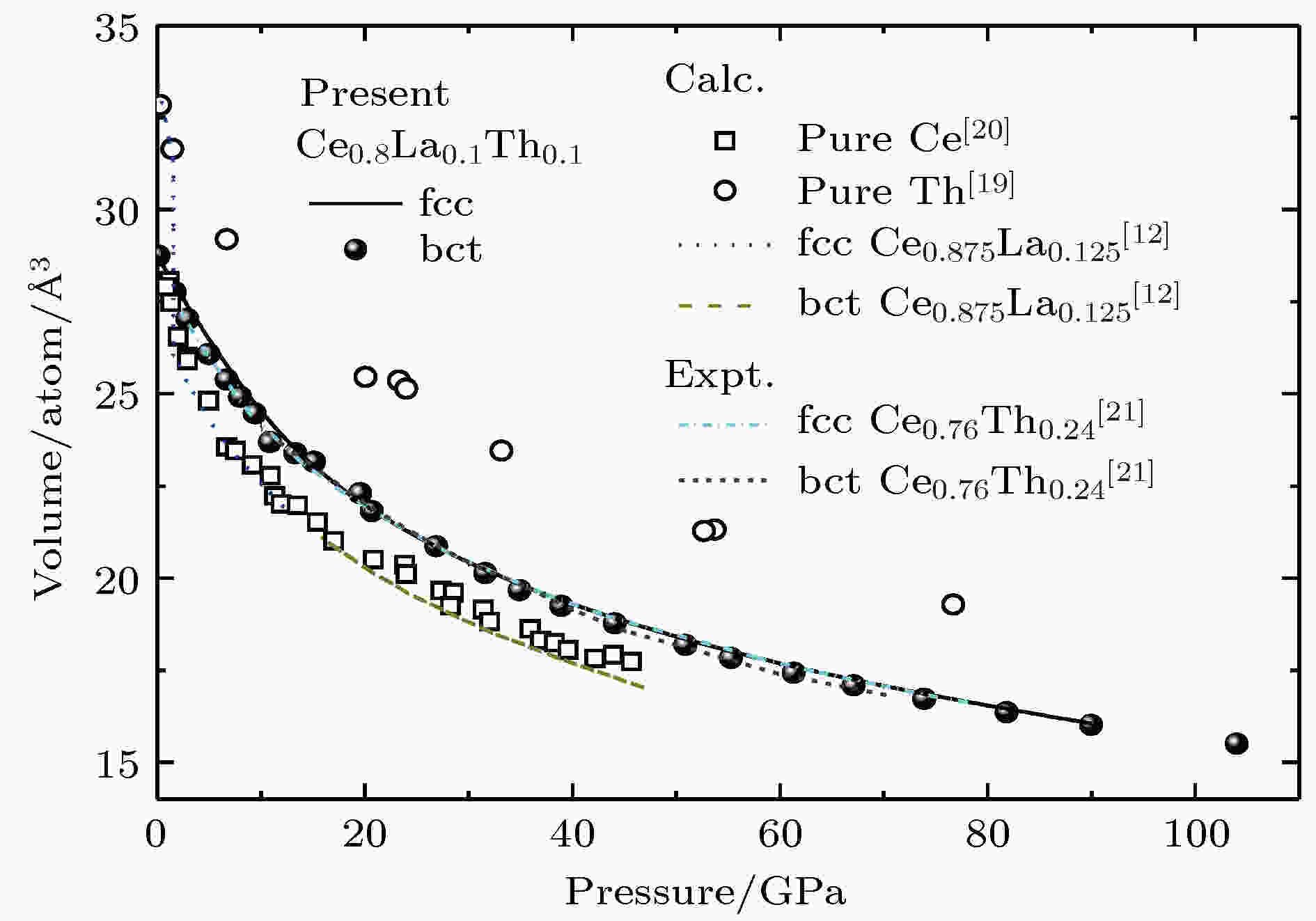
2019, 68 (8): 086401.
doi: 10.7498/aps.68.20182128
Abstract +
The lanthanide and actinide metals and alloys are of great interest in experimental and theoretical high-pressure research, because of the unique behavior of the f electrons under pressure and their delocalization and participation in bonding. Cerium (Ce) metal is the first lanthanide element with a 4f electron. It has a very complex phase diagram and displays intriguing physical and chemical properties. In addition, it is expected to be an excellent surrogate candidate for plutonium (Pu), one of the radioactive transuranic actinides with a 5f electron. The bulk properties and phase transformation characteristics of Ce-based alloys are similar to those of Pu and its compounds. Thus, the investigations of Ce-based alloys are necessary and can potentially advance the understanding of the behavior of Pu. In this work, the equation of state, phase transition, elastic and thermodynamic properties of Ce0.8La0.1Th0.1 alloy at high pressure are investigated by using first-principles calculations based on the density-functional theory. The structural properties of the Ce0.8La0.1Th0.1 alloy are in good agreement with the available experimental and theoretical data. The lattice constant a decreases with pressure increasing, while c shows an opposite variation. It is found that the lattice parameter c shows abnormal jump. And the critical volume is located at 20.1 Å3. The axial ratio jumps from a value of about $\sqrt 2 $ (corresponding to the fcc structure) to a higher value, which indicates that the fcc-bct transition occurs. And the corresponding transition pressure is located at ~31.6 GPa. When the pressure rises to 34.9 GPa, the bct structure displays a saturated c/a axial ratio close to about 1.67. The Young's modulus E, shear modulus G and the Debye temperature of the fcc phase tend to be " softened” around the phase transition pressure. The vibrational free energy is obtained by using the quasi-harmonic Debye model. And then the thermodynamic properties including the thermal equation of state, heat capacity and entropy under high pressure and high temperature are also predicted successfully. The results show that the heat capacity and entropy increase rapidly with temperature increasing, and decrease with pressure increasing. The high pressure can suppress part of the anharmonicity caused by temperature.

2019, 68 (8): 086501.
doi: 10.7498/aps.68.20190194
Abstract +
Because of high surface-to-volume ratio (SVR), the most prominent size effect limiting thermal transport originates from the phonon-surface scattering in nanostructures. Here in this work, we propose the mechanism of phonon scattering by the under-coordinated atoms on surface, and derive the phonon scattering rate of this mechanism by quantum perturbation theory combined with bond order theory. The scattering rate of this mechanism is proportional to SVR, therefore the effect of this mechanism on phonon transport increases with the feature-size of nanostructures decreasing. Due to the ω4 dependence of scattering rate for this mechanism, the high-frequency phonons suffer a much stronger scattering than the low-frequency phonons from the under-coordinated atoms on surface. By incorporating this phonon-surface scattering mechanism into the phonon Boltzmann transport equation, we calculate the thermal conductivity of silicon thin films and silicon nanowires. It is found that the calculated results obtained with our model are closer to the experimental data than those with the classical phonon-boundary scattering model. Furthermore, we demonstrate that the influence of this phonon-surface scattering mechanism on thermal transport is not important at a very low temperature due to the Bose-Einstein distribution of phonons. However, with the increase of the temperature, more and more phonons occupy the high-frequency states, and the influence of this scattering mechanism on phonon transport increases. It is astonished that the phonon scattering induced by the under-coordinated atoms on surface is the dominant mechanism in governing phonon heat transport in silicon nanostructures at room temperature. Our findings are helpful not only in understanding the mechanism of phonon-surface scattering, but also in manipulating thermal transport in nanostructures for surface engineering.
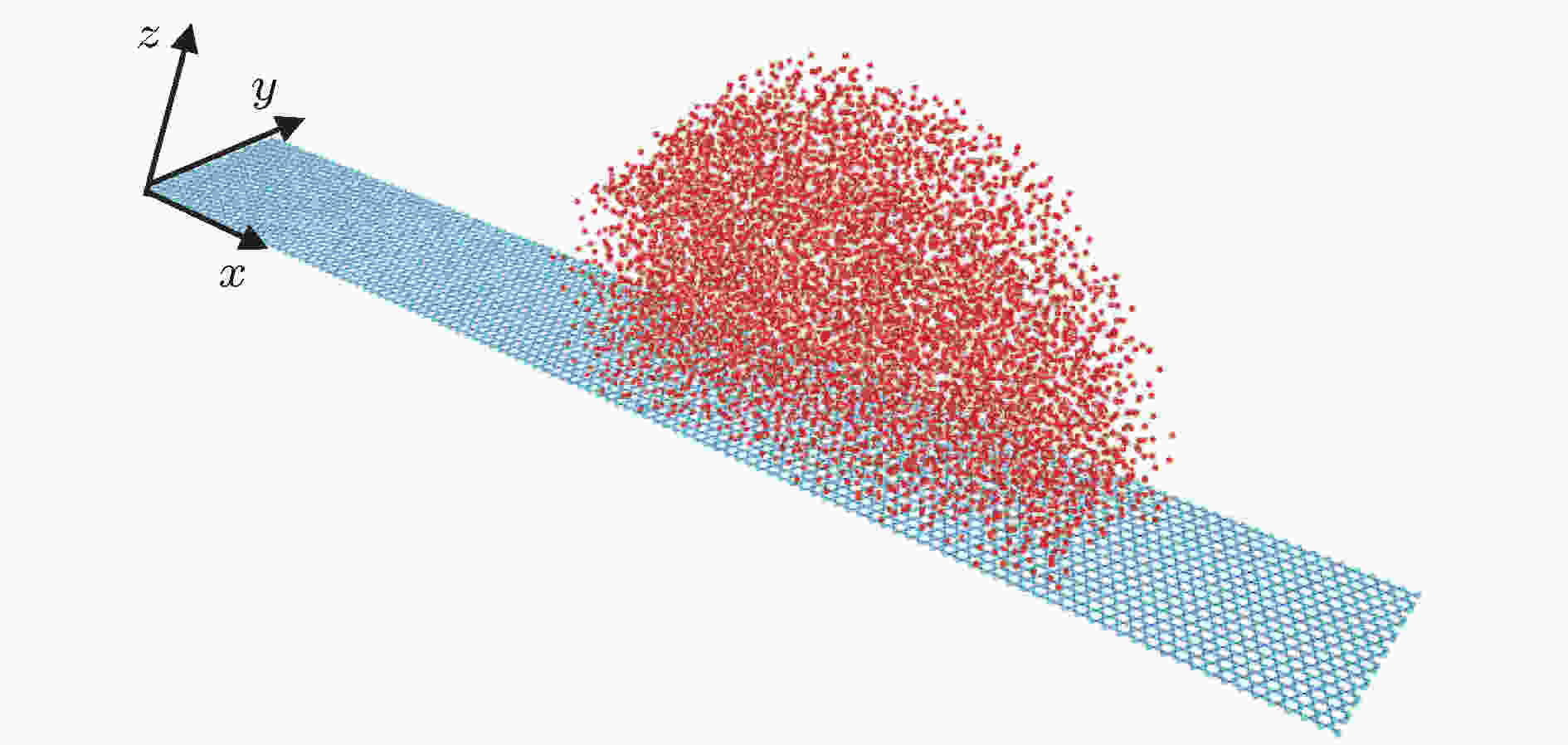
2019, 68 (8): 086801.
doi: 10.7498/aps.68.20182307
Abstract +
Graphene has received a lot of attention for its excellent physical and chemical properties, and the unique wettability of graphene is still under investigation. Most of previous studies focused on graphene or carbon nanotubes, and less of them on the comparison of wettability between graphene and other materials to reveal the characteristic wettability of graphene. In the present study, the wettability of monolayer graphene, copper and silica are studied by using the molecular dynamics simulation, in which the contact angle and the water molecule arrangement (i.e. density distribution and angle distribution of water molecules) on the substrates are analyzed. The results show that although both copper and graphene are weak hydrophilic materials, there are two neat layers of water molecule structure on the surface of graphene, and water molecules are disordered on the surface of copper. Silica is a kind of strong hydrophilic material and graphene is a kind of weak hydrophilic material, but both of them have two layers of dense water molecule layer, which are in different states, on the surface. On the silica surface, the two layers of water molecules, whose densities are greatly different, are close to the substrate, and hydrogen bonds are randomly arranged, which is very different from the arrangement of water molecules on the graphene surface. By making a comparison of wettability among the three materials, the characteristic water molecule arrangement on graphene surface is obtained: there exist two layers of water molecules on the surface of graphene. Within the dense layer of water molecules near the substrate, the angles between the O−H bonds of water molecule and the vertical direction of substrate focus on 90°, while the hydrogen bonds on the surface are almost perpendicular to the substrate. Furthermore, it is found that adding a layer of graphene on copper (the main force between water molecules and copper is van der Waals force) will have a less influence on copper wettability. However, adding a layer of graphene on silica (the main force between water molecule and silica is from chemical bonds) will have a significant influence on the wettability of silica, i.e. not only the upper contact angle increases significantly, but also the arrangement of water molecules on the surface of the substrate becomes similar to that of graphene. These simulated results are found to be in agreement with the experimental results of Rafiee et al. [Rafiee J, Mi X, Gullapalli H, Thomas A V, Yavari F, Shi Y, Ajayan P M, Koratkar N A 2012 Nature 11 217]. This work can provide a theoretical guidance for further developing the applications of graphene in microstructure design.
CONDENSED MATTER: ELECTRONIC STRUCTURE, ELECTRICAL, MAGNETIC, AND OPTICAL PROPERTIES

2019, 68 (8): 087101.
doi: 10.7498/aps.68.20182238
Abstract +
For ZnO which is not magnetic itself, it is of great significance to study the source of ferromagnetism and its photoelectric properties when Cu doped ZnO coexists with internal defects. The effects of intrinsic defects on the electronic structures, magnetic and optical properties of Cu-doped ZnO (CuZn) are studied by using first principle calculations based on the density functional theory combined with the Hubbard U (DFT + Ud + Up). The results indicate that the doped Cu is a substitute acceptor, and the manufacturing environment plays an important role in forming the CuZn with internal defects. Under the oxygen-rich condition, the doped Cu is favorable for forming internal defects, and the CuZn—Oi bonds are easily formed. On the contrary, the Cu-doped ZnO is not conducive to forming internal defects under the O-poor condition. The 3d electrons of the substitute Cu form the unoccupied accepter energy level at the top of valence band, generating p-type conduction. Comparing with CuZn system, the carrier concentration of positive hole decreases in CuZn-VO system and the conductivity is poor. In the CuZn-VZn system, the number of carrier holes is almost constant, and the conductivity has no effect. In the CuZn-Oi model, the carrier concentration of positive holes increases and the conductivity gets better. The pure ZnO system exhibits non-magnetic behavior. The study also reveals that the smaller the electro-negativity, the greater the contribution to magnetic moment is when O atom is connected with Cu atom. The magnetic moments in CuZn and CuZn-Oi system are mainly generated by the coupling between the Cu 3d and the O 2p orbital on the c axis. When VO and VZn exist in CuZn, the magnetic moment is mainly caused by the strong coupling of Cu 3d with O 2p in ab plane. In the presence of VZn in CuZn, the magnetism also contains the contribution of the spin polarization of O(5, 6) atoms around VZn. In the defect states of CuZn-VZn and CuZn-Oi, the induced states in the deep energy levels are generated by the interaction between the O-O 2s orbital electrons. The reduced optical band gap of the CuZn model results in the red shift of absorption spectrum. The enhanced absorption and reflection of the CuZn-VZn model reduce the transmission.

EDITOR'S SUGGESTION
2019, 68 (8): 087201.
doi: 10.7498/aps.68.20182218
Abstract +

2019, 68 (8): 087302.
doi: 10.7498/aps.68.20181967
Abstract +
Recently, flexible electronic devices have attracted extensive attention due to their characteristics of flexibility, miniaturization and portability. Flexible functional oxide thin films with high performance and stability are the basis for high-performance flexible electronic devices. Perovskite lead zirconate titanate Pb(Zr0.53Ti0.47)O3 (PZT) at "morphotropic phase boundary" indicates excellent ferroelectricity and piezoelectricity, and has broad prospects in flexible non-volatile memories, sensors and actuators. Moreover, high-temperature stable flexible memories and sensors have received increasing attention due to the escalating complexity of the external environment. In the present work, Pb(Zr0.53Ti0.47)O3/SrRuO3/BaTiO3 (PZT/SRO/BTO) heterostructures are prepared by pulsed laser deposition on high temperature resistant two-dimensional layered fluorphlogopite mica substrates. Afterward, flexible epitaxial PZT thin films are obtained by mechanical stripping. The ferroelectricity, piezoelectricity and high temperature characteristics of PZT thin films are investigated. The thin films show superior ferroelectricity at room and high temperatures. At room temperature, the thin films exhibit excellent ferroelectricity with a remnant polarization (Pr) of ~$ {\rm{65}}\;{\text{μ}} {\rm{C/c}}{{\rm{m}}^{\rm{2}}}$ . A saturation polarization (Ps) of ~$ {\rm{80}}\;{\text{μ}} {\rm{C/c}}{{\rm{m}}^{\rm{2}}}$ and a coercive field (Ec) of ~100 kV/cm are also observed. In addition, after bending the thin films to a 1.5 cm radius 104 times, their ferroelectricity does not show deterioration at room temperature. In order to study the ferroelectricity of PZT thin films at high temperature, P-E loops from 27 ℃ to 275 ℃ are tested. The results show that the films still show excellent ferroelectricity with a Pr of ~$ {\rm{50}}\;{\text{μ}} {\rm{C/c}}{{\rm{m}}^{\rm{2}}}$ and a Ps of ~$ {\rm{70}}\;{\text{μ}} {\rm{C/c}}{{\rm{m}}^{\rm{2}}}$ at 275 ℃. The present work provides a basis for the application of flexible epitaxial PZT thin film. Especially, the ferroelectricity of flexible PZT thin films at high temperature provides a possibility of obtaining high-temperature flexible electronic devices.

2019, 68 (8): 087802.
doi: 10.7498/aps.68.20182225
Abstract +
As an important branch of metamaterial-based devices, metamaterial absorber (MA) has aroused great interest and made great progress in the past several years. By manipulating the magnetic resonance and the electric resonance simultaneously, the effective impedance of MA will match the free space impedance, thus resulting in a perfect absorption of incident waves. Due to the advantages of thin thickness, high efficiency and tunable property, MA has been widely concerned in energy-harvesting and electromagnetic stealth. Since the first demonstration of MA in 2008, many MAs have been extensively studied in different regions, such as microwave frequency, THz, infrared frequency and optical frequency. At the same time, the absorber has been extended from the single-band to the dual-band, triple-band, multiple-band and broadband. In recent years, the dual-band absorber has received significant attention and has been widely studied. So far, however, most of MAs are composed of a bottom continuous metallic layer, which prevents electromagnetic waves from penetrating and makes electromagnetic waves absorbed or reflected. In this paper, an ultrathin flexible transmission absorber with a total thickness of 0.288 mm is designed and fabricated, which can be conformally integrated on an object with a curved surface. The absorber consists of three layers of structure: the bottom is a one-dimensional grating type metal line, the middle is the medium layer, and the surface metal layer is composed of two different sizes metal lines in parallel. Simulation and experimental results show that the absorptions of TE wave are 97.5% and 96.0% respectively at the two frequency points of 5 GHz and 7 GHz. The transmission of the TM wave above 90% is maintained from 3 GHz to 6.5 GHz. We also simulate the spatial electric field distribution and magnetic field distribution at two resonant frequencies, and explain the electromagnetic absorption mechanism of the proposed structure for TE wave. Secondly, when the incident angle increases to 60 degrees, the performance of the absorber is substantially unaffected, exhibiting good wide-angle characteristics. In addition, through the analysis of structural parameters, two absorption peaks of the proposed absorber can be independently adjusted, resulting in a flexible design. In conclusion, we propose both theoretically and experimentally a polarization-controlled transmission-type dual-band metamaterial absorber that can absorb the TE waves and transmit the TM wave efficiently, which has important applications in the case requiring bidirectional communication.
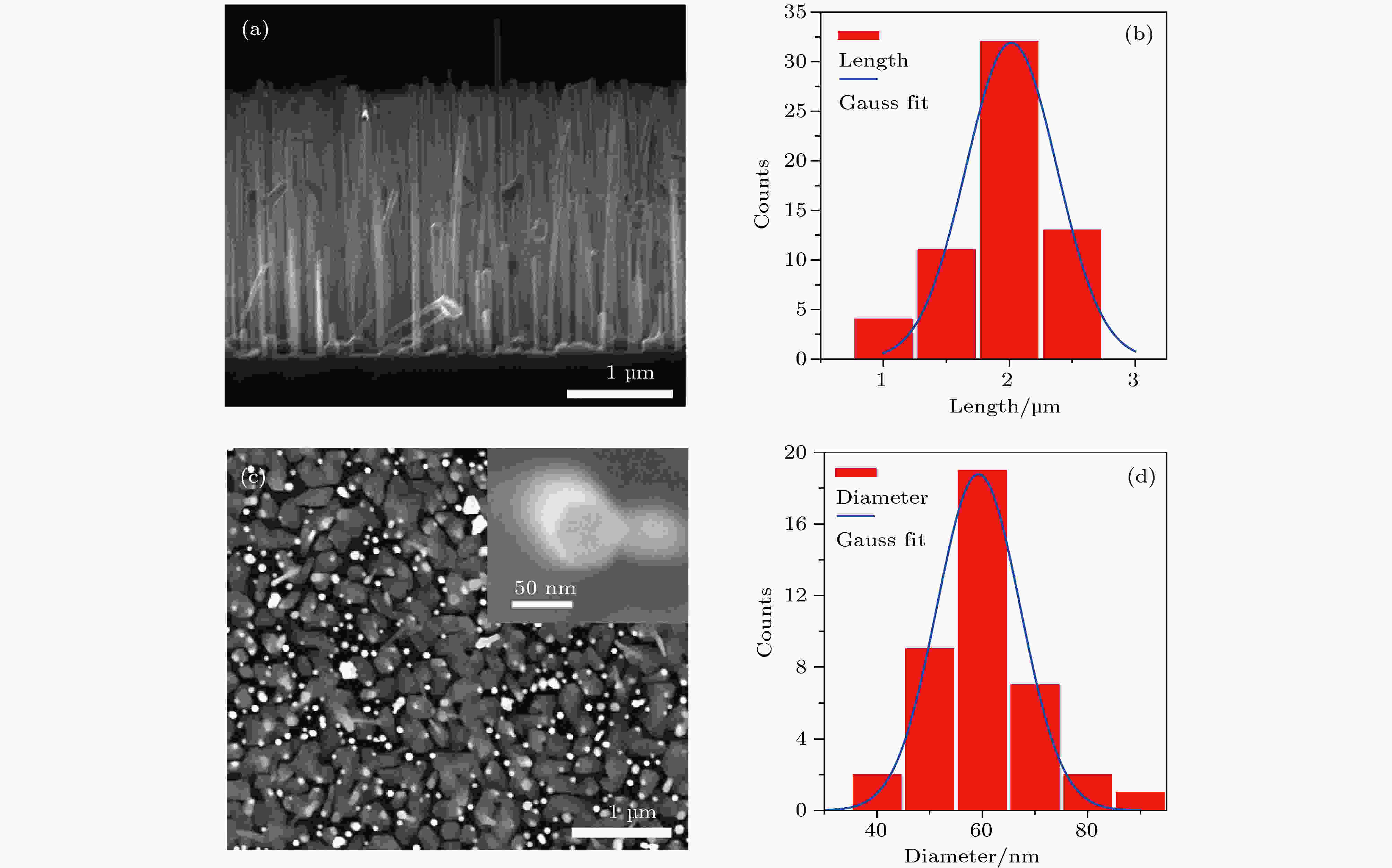
2019, 68 (8): 087803.
doi: 10.7498/aps.68.20182116
Abstract +
Gallium arsenide (GaAs) nanowires are epitaxially grown on an N-type Si (111) substrate by molecular beam epitaxy according to self-catalysis growth mechanism. Testing the grown nanowires by scanning electron microscope, it is found that the nanowires have high verticality and good uniformity in length and diameter. Variable temperature photoluminescence (PL) spectroscopy is used on nanowires. The test results show that the two luminescence peaks P1 and P2 at 10 K are located at 1.493 eV and 1.516 eV, respectively, and it is inferred that it may be the luminescence caused by WZ/ZB miscible structure and the free exciton luminescence peak. These two peaks present red-shift with temperature increasing. The temperature change curve is obtained by fitting the Varshni formula. The variable power PL spectroscopy test finds that the peak position of P1 position is blue shifted with power increasing, but the peak position of the P2 remains unchanged. By fitting, it is found that the P1 peak position is linearly related to power to the power of 1/3, and it is judged that it may be type-II luminescence caused by WZ/ZB mixed phase structure. At the same time, the peak position of the P2 position is fitted and parameter α approximately equals 1.56, therefore P2 is a free exciton luminescence. A Raman spectrum test is performed on the nanowires, and an E2 phonon peak unique to the GaAs WZ structure is found from the spectrum. It is proved that the grown nanowires possess WZ/ZB mixed phase structures, and the hybrid phase structure of nanowires is more intuitively observed by high resolution transmission electron microscopy.
INTERDISCIPLINARY PHYSICS AND RELATED AREAS OF SCIENCE AND TECHNOLOGY

2019, 68 (8): 088701.
doi: 10.7498/aps.68.20190055
Abstract +
Dose reduction becomes one of the hot research fields in the most commonly used helical computed tomography (CT) for clinical diagnostic. Local imaging using a collimator can effectively lower the CT radiation dose by reducing the direct irradiation area. Due to the limitation of the exposing area, the projection data used for local imaging reconstruction are usually truncated, resulting in local reconstruction problems. The key in local image reconstruction is how to deal with the horizontal truncation of the projection data. The helical cone beam back-projection filtration (BPF) algorithm only needs to ensure the integrity of the projections of PI line to realize the reconstruction of the entire PI line, making local reconstruction possible. Due to the complexity and irregularity of the spatial distribution of PI lines, the existing helical BPF algorithms can only realize local surface reconstruction, whereas the local volume reconstruction is difficult. For the BPF algorithm in designing the PI line and the sampling points in helical cone beam CT and the difficulty in local volume reconstruction, the tilted fan-beam back-projection filtration (TFB-BPF) reconstruction algorithm is proposed by utilizing the weighted correction and coordinate expansion, based on the circular fan beam BPF. The algorithm divides the reconstruction area into several slices, constructs the inclined fan beam geometry for each layer, and slice-by-slice reconstruction is conducted by using the weighted modified tilted fan beam BPF algorithm. The most powerful feature of the algorithm is that the filter line, equivalent to the PI line in the original helical BPF algorithm, is selected in a two-dimensional plane. Therefore, it is more concise and efficient and can be applied to the reconstruction of local volume regions. In this paper, the helical cone beam CT imaging geometry and the original helical cone beam BPF algorithm are introduced. Then, the TFB-BPF reconstruction algorithm is deduced. Experimental results show that the algorithm can effectively realize the local volume reconstruction and overall improved image quality without obvious truncation artifacts.
GEOPHYSICS, ASTRONOMY, AND ASTROPHYSICS

2019, 68 (8): 089701.
doi: 10.7498/aps.68.20182232
Abstract +
Navigation ground verification is an essential part of X-ray pulsar navigation (XPNAV) research. Aiming at the need of real and continuous pulsar signals for navigation algorithm verification, and to avoid the difficulties and high costs of X-ray modulation and detection, we propose an XPNAV ground verification system based on visible light source. In this system, the pulsar signal model at the solar system barycenter and the orbit information are used to establish the real-time photon arrival rate function at a spacecraft, and then the rate function is digitized and converted into voltage signal by the designed hardware system to drive a linear light source. After the processes of light attenuation, signal detection and pulse discrimination are experienced, the real-time photon time of arrivals (TOAs) at a spacecraft can be achieved. These photon TOAs contain characteristics of the pulsar profiles and frequency, the time propagation effect in the solar system, and cosmic X-ray background. The system uses semi-physical devices to modulate and attenuate visible light, and judges whether the spacecraft can observe the navigation pulsar according to the real position, thereby realizing the simulation of X-ray propagation in space. At present, the detection method of pulsar observation with single detector include detection of single pulsar, time division detection of multiple pulsars, and simultaneous detection of multiple pulsars. The system has four channels, each of which has three output modes mentioned above, and can support the verification of multiple navigation modes. This system consists of signal simulator and controller, single photon generator and detector, single photon screening and time tagging, and navigation algorithm verification. This paper presents the testing results of the system characteristics, the authenticity of the simulated photon arrival time series and the navigation verification. Monte Carlo experiments show that the recording accuracy of photon arrival time is 10 ns and the delays of the four channels are (11 ± 2), (15 ± 4), (14 ± 3), and (16 ± 4) ${\text{μ}}{\rm{s}}$ , respectively. The multi-physical properties of simulated photon arrival time series are introduced in detail, including photon flux, shape of observation profile, pulsar frequency characteristics and Doppler shift. The position and velocity errors of autonomous navigation algorithm test are 13.587 km and 14.277 m·s–1, respectively, with an orbital altitude 26610 km and within 10 h. The ground verification system adopts master-slave control mode, the master computer mainly implements parameter setting and navigation algorithm verification, and the slave computer mainly carry out pulsar signal simulation. The communication based on TCP/IP protocol is applied to realize parameter transmission and real-time control between the master and slave computers in navigation verification process. The results of performance and functional test show that the system is available to accomplish the simulation of photon TOAs of X-ray pulsars at a spacecraft in real time and implement the ground verification of XPNAV.



































